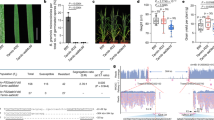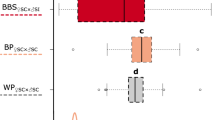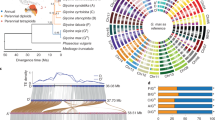Abstract
The genetic control of self-incompatibility and the number of S-alleles were studied in a population of Phlox drummondii from Lytle, Texas. Thirty-four seedlings were transplanted to the greenhouse. Each was self-fertilized (using bud pollination) to generate self families of 9–11 plants. Complete diallels were performed within each family. Twenty-four families contained three cross-compatibility phenotypes whose crossing relationships indicated that self-incompatibility was under gametophytic control and governed by one gene. Homozygotes from twenty-four families were crossed in a half-diallel for S-genotype assignment. Thirty S-alleles were detected. Allele frequencies did not deviate significantly from equality.
Similar content being viewed by others
Article PDF
References
Ascher, P. 1976. Self-incompatibility systems in floricultural crops. Acta Hort, 63, 205–215.
Atwood, S S. 1944. Oppositional alleles in natural populations of Trifolium repens. Genetics, 29, 428–435.
Bateman, A J. 1954. Self-incompatibility systems in angiosperms. II. Iberis amara. Heredity, 8, 305–332.
Campbell, J M, and Lawrence, M D. 1981a. The population genetics of the self-incompatibility polymorphism in Papaver rhoeas I. The number and distribution of S-alleles in families from three localities. Heredity, 46, 69–79.
Campbell, J M, and Lawrence, M D. 1981b. The population genetics of the self-incompatibilty polymorphism in Papaver rhoeas II. The number and frequency of S-alleles in a natural population (R106). Heredity, 46, 81–90.
Crosby, J L. 1966. Self-incompatibility alleles in the population of Oenothera organensis. Evolution, 20, 567–579.
Emerson, S. 1939. A preliminary survey of the Oenothera organensis population. Genetics, 24, 524–537.
Emerson, S. 1940. Growth of incompatible tubes in Oenothera organensis. Bot Gaz, 191, 890–911.
Ewens, W J. 1964. On the problem of self-sterility alleles. Heredity, 21, 1433–1438.
Fisher, R A. 1958. The Genetical Theory of Natural Selection, 2nd rev. ed. Dover Publications, New York.
Ford, M A, and Kay, Q O N. 1985. The genetics of incompatibility in Sinapis arvensis L. Heredity, 54, 99–102.
Karron, J D, Marshall, D L, and Oliveras, D M. 1990. Number of sporophytic self-incompatibility alleles in populations of wild radish. Theor Appl Genet, 79, 457–460.
Lawrence, M J. 1975. The genetics of self-incompatibility in Papaver rhoeas. Proc R Soc Lond B, 188, 275–285.
Lawrence, M J, and O'Donnell, S. 1981. The population genetics of the self-incompatibility polymorphism in Papaver rhoeas II. The number and frequency of S-alleles in two further natural populations (R 102 and R 104). Heredity, 47, 53–61.
Levin, D A. 1975. Gametophytic selection in Phlox. In: D. L. Mulcahy (ed.) Gamete Competition in Plants and Animals, American Elsevier, New York, pp. 207–217.
Levin, D A. 1985. Reproductive character displacement in Phlox. Evolution, 39, 1275–1281.
Levin, D A. 1989. Proximity-dependent cross-compatibility in Phlox. Evolution, 43, 1114–1116.
Mantel, N. 1974. Approaches to a health research occupancy problem. Biometrics, 30, 355–362.
Nagylaki, T. 1975. The deterministic behaviour of self-incompatibility alleles. Genetics, 79, 545–550.
De Nettancourt, D. 1977. Incompatibility in Angiosperms. Springer-Verlag, Berlin.
Paxman, G J. 1963. The maximum likelihood estimation of the number of self-sterility alleles in a population. Genetics, 48, 1029–1032.
Richards, A J. 1986. Plant Breeding Systems. Allen & Unwin, London.
Sampson, D R. 1967. Frequency and distribution of self-incompatibility alleles in Raphanus raphanistrum. Genetics, 56, 241–251.
Stevens, J P, and Kay, Q O N. 1989. The number of loci controlling the sporophytic self-incompatibility system in Sinapis arvensis L. Heredity, 61, 411–418.
Watkins, L, and Levin, D A. 1990. Outcrossing rates as related to plant density in Phlox drummondii. Heredity, 65, 81–89.
Williams, R D, and Williams, W. 1947. Genetics of red clover (Trifolium pratense L.) compatibility. III. The frequency of incompatibility S-alleles in two non-pedigree populations of red clover. J Genet, 48, 67–79.
Wright, S. 1939. The distribution of self-sterility alleles in populations. Genetics, 24, 538–552.
Wright, S. 1964. The distribution of self-incompatibility alleles in populations. Evolution, 18, 609–619.
Yokoyama, S, and Nei, M. 1979. Population dynamics of sex determining alleles in honeybees and self-incompatibility alleles in plants. Genetics, 91, 609–626.
Yokoyama, S, and Hetherington, L E. 1982. The expected number of self-incompatibility alleles in finite plant populations. Heredity, 48, 299–303.
Author information
Authors and Affiliations
Rights and permissions
About this article
Cite this article
Levin, D. S-gene polymorphism in Phlox drummondii. Heredity 71, 193–198 (1993). https://doi.org/10.1038/hdy.1993.124
Received:
Issue date:
DOI: https://doi.org/10.1038/hdy.1993.124
Keywords
This article is cited by
-
Sites of self-pollen tube inhibition in Papaveraceae (sensu lato)
Plant Systematics and Evolution (2012)
-
Mating system and the hybridization between self-compatible Phlox cuspidata and self-incompatible Phlox drummondii
Evolutionary Ecology (2009)
-
Inheritance and dominance of self-incompatibility alleles in polyploid Arabidopsis lyrata
Heredity (2004)
-
The genetic control of self-incompatibility in Linanthus parviflorus (Polemoniaceae)
Heredity (1997)
-
S-allele diversity in a natural population of Physalis crassifolia (Solanaceae) (ground cherry) assessed by RT-PCR
Heredity (1996)



